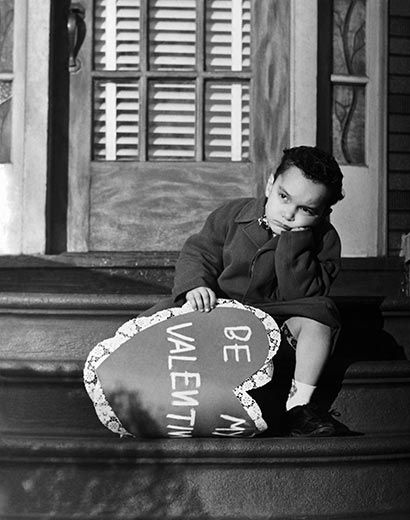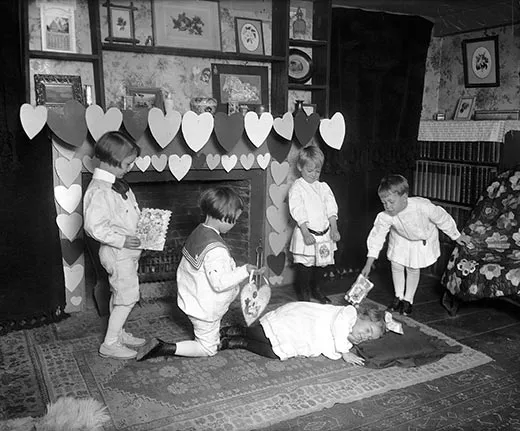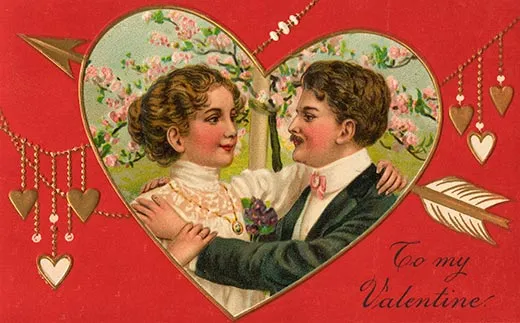Ten Out-of-the-Ordinary Valentine’s Day Customs
From the festivals of ancient Rome to modern campaigns, the holiday hasn’t always been about roses and candy
/https://tf-cmsv2-smithsonianmag-media.s3.amazonaws.com/filer/children-exchanging-Valentines-631.jpg)
1. Ballot Box: In ancient Rome, when Valentine’s Day was still a pagan festival, young women would put their names in a box, to be randomly chosen by men—who, according to one account, “paid particular attention to the young women whose name they drew.” Early Christian leaders tried to discourage the practice by substituting saints’ names for women’s, but the tradition persisted.
A traveler’s diary from the early 18th century notes: “On the eve of St Valentine's Day… An equal number of maids and bachelors get together; each writes his or her true or some feigned name upon separate billets, which they roll up, and draw by way of lots, the maids taking the men’s billets, and the men the maids’….Fortune having thus divided the company into so many couples, the valentines give balls and treats to their mistresses [and] wear their billets several days upon their bosoms or sleeves.”
2. Gloves & Love: Prior to the Elizabethan era, gloves were worn almost exclusively by men. But, by the late 16th century, gloves became a traditional Valentine’s Day gift for women. In fact, it became custom for a young woman to approach her man of choice and utter the verse: “Good-morrow Valentine, I go today; To wear for you, what you must pay; A pair of gloves next Easter Day.” Having thus been ambushed, the man was expected to send the woman a gift of gloves to wear on Easter Sunday. Sometimes men sent women gloves without an invitation. If the lady wore the gloves on Easter, it was a sign that she favored the gentleman’s romantic overtures.
3. Sweet Dreams: In the 1700s, rural Englishwomen would pin five bay leaves to their pillows—four on the corners, one in the middle—on the evening before Valentine’s Day. By doing so, it was said, they would see their future husbands in their dreams. A variation of this tradition called for women to sprinkle bay leaves with rosewater and lay them across their pillows. “When you go to bed put on a clean nightgown turned wrong side outwards,” reads one folkloric account, “and, lying down, say these words softly to yourself: ‘Good Valentine, be kind to me, In dreams let me my true love see.’ ”
4. Sing Out Loud: In the 18th and 19th centuries, British children celebrated Valentine’s Day by going door to door, singing songs and sometimes begging for treats, such as fruit, pennies and cakes. Folklorists and historians have preserved the lyrics of some of these tunes: “Morrow, morrow, Valentine, I'll be yourn if you'll be mine, Please to us a Valentine”; and “Good morning, Valentine, Curl your locks as I do mine, Two before and three behind, So good morning, Valentine.” Some of the songs were a bit more ribald, such as this ditty: “Good morrow, Valentine, How thundering Hot. When Father’s pig die, Yow shall ha’ its jot.” (“Jot” was slang for pig intestines. Kids will be kids.)
5. Leaps of Love: In the 19th century, Valentine’s Day cards in the United States and Britain began capitalizing on the tradition of “Leap Day”—the one day, every four years, when proper society permitted women to propose marriage. As the British magazine Punch observed in 1872: “This being Leap Year, if a single gentleman receives a Valentine from a single lady, and can trace the sender through the Post-office, he will be entitled to consider her missive as equivalent to a proposal of marriage, and to accept it, if the lady can give satisfactory references as to property, connections, temper, accomplishments, and ability to manage a modern mansion.”
Satirists had a field day writing about the terror of single men. An 1880 leap-year poem mused: “Maidens’ dissembling day; Bachelors’ trembling day; Men walk in trouble and fear; Girls run and skip about, daintily trip about; Knowing St. Valentine’s here.”
6. Poisoned Pens: Not all Valentine’s Day cards celebrated love. During the 1840s and 1850s—as caricatures emerged as a popular art form—so too did demand for satirical cards. Even by today’s standards, the imagery was bawdy, and, at their worst, these “mock Valentines” were a petty excuse for cruelty. “They lampooned people of all trades and professions; they stereotyped racial and ethnic groups, especially African-Americans and the Irish,” writes Leigh Eric Schmidt, currently a professor of American religious history at Princeton University. “Women were a particular target of attack valentines. Widows, old maids, loud or assertive women, flirts and coquettes were standard subjects of misogynistic derision…. Intractable, willful, or publicly active women were portrayed as devils, snakes, tigers, or hissing cats.”
The “mock Valentine” craze eventually waned—but not before an 1860 column in the New York Times bemoaned that, in recent years, “St. Valentine’s votaries ceased to be poets and became buffoons and his pleasant missives were degraded into vulgar vehicles of silly caricature and indecent impertinence.”
7. Eat Your Heart Out: French women traditionally have relied on subtle culinary cues to signal their amorous intentions. The July 1956 issue of the journal Western Folklore reported: “a young maid lets her swain know whether the answer is ‘yes’ or ‘no’ by what she feeds him on St. Valentine’s Day. It's a custom that goes back for centuries. Any egg dish, for example, definitely means No! On the other hand, an apple or pear means Yes!”
8. Role Reversal: After an executive at the Mary Chocolate Company introduced Valentine’s Day to Japan in 1957, an error in translation led Japanese marketers to believe that tradition called for women to send chocolate candies to men. Now, “Many Japanese consider Valentine’s Day the one occasion in which women are allowed the greatest amount of personal expression,” writes Millie Creighton, an associate professor in the department of anthropology and sociology at the University of British Columbia. “A high-ranking official at one department store asserts, ‘This is the only day girls can express their feelings very openly.’ ”
9. On the March: Every year since 2003, the human rights group Women of Zimbabwe Arise (WOZA) has held peaceful demonstrations on Valentine’s Day, demanding access to education, health care and an end to government oppression of activists. Dressing in red and white outfits, they distribute paper roses and cards with messages such as, “Defend your right to love and let love overcome hate. Defend all your rights and stand up for the truth.” Several prominent WOZA activists have been arrested during these Valentine’s Day protests—including Magodonga Mahlangu, who later received the Robert F. Kennedy Human Rights Award on November 23, 2009.
10. To Your Health: In recent years, Valentine’s Day has emerged as an occasion for public health education. The U.S. Centers for Disease Control seek to raise awareness about heart disease, with e-cards that read: “Valentine, dear Valentine, My heart beats just for you. To keep our hearts beating, Let’s walk a mile or two.” (Hey, they’re doctors, not poets.)
Worldwide, the holiday also has become an occasion for holding AIDS prevention workshops. “Valentine’s Day offers more opportunity [for AIDS education] than any other day,” writes columnist Joseph Adeyeye of Nigeria, where 2.6 million people are living with HIV/AIDS, the second largest number in any country in the world. “It is the period when teenagers, especially, come under the greatest form of pressure to undertake risky sexual behaviors.”
Perhaps inevitably, pharmaceutical companies also caught on. In 2000, Pfizer, the manufacturer of Viagra, funded a Valentine’s Day impotence awareness campaign in Britain.
/https://tf-cmsv2-smithsonianmag-media.s3.amazonaws.com/accounts/headshot/mark-strauss-240.jpg)



/https://tf-cmsv2-smithsonianmag-media.s3.amazonaws.com/accounts/headshot/mark-strauss-240.jpg)